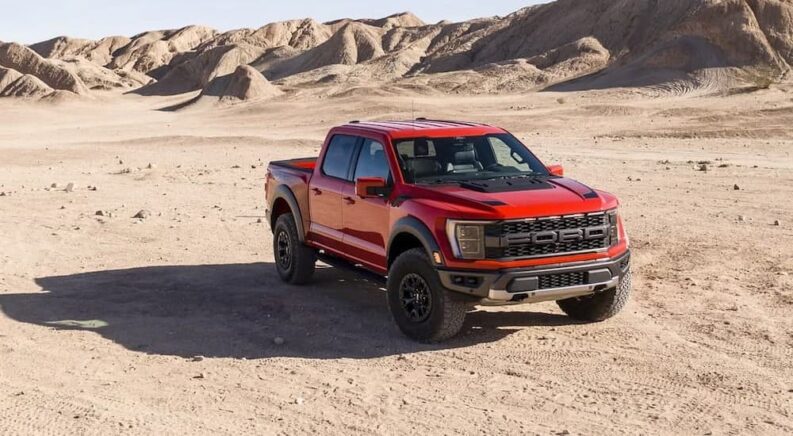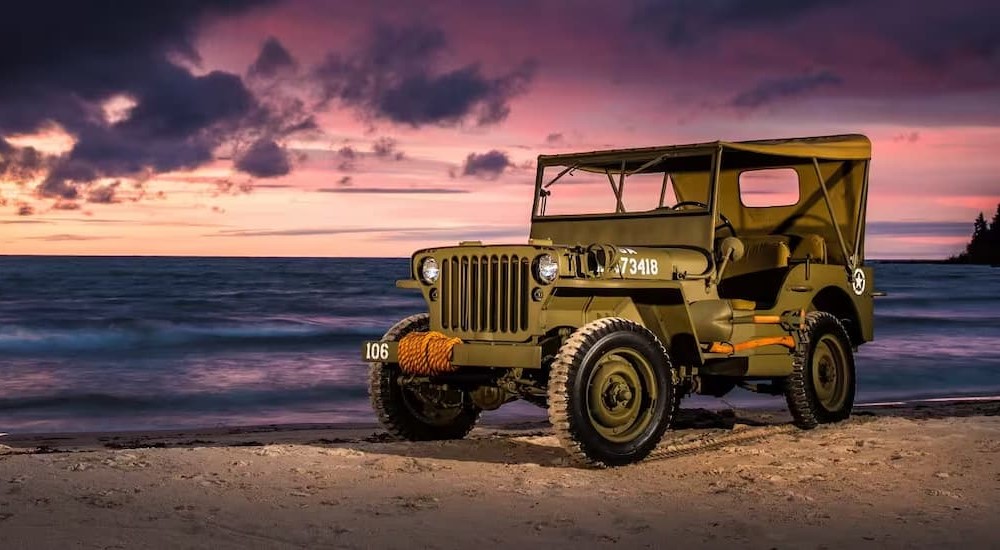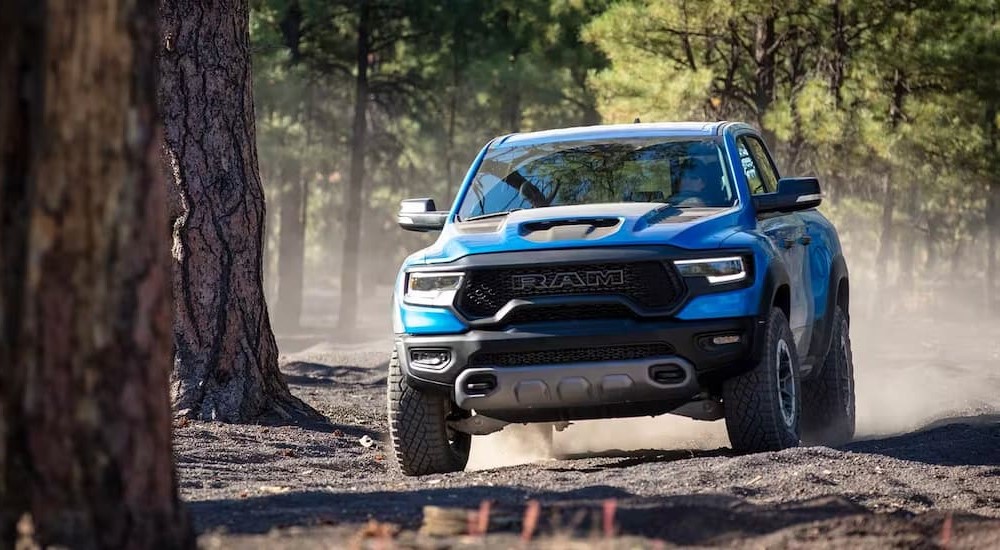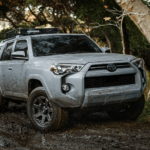Who would want to drive on a nice, paved road when you could be carving through muddy ruts, bouncing in your seat, and learning the meaning of “center of gravity” first-hand? As long as there have been cars, there have been drivers who will find any excuse to test their limits with off-road driving. While this was a tall order for some of the earliest vehicles, dedicated off-road models soon emerged in response to the very specific automotive needs of a world at war. Today, off-road trucks and SUVs represent one of the fastest-growing segments in the auto market, with more dedicated off-road models and trims hitting dealerships with every passing year.
Once reserved for those who were handy with a welding torch and not afraid of wrecking their one-of-a-kind creations, off-road vehicles are now a practical, accessible, and affordable choice for those seeking used trucks for sale. But where did off-roading get its start, how have these vehicles changed over the decades, and what does the future hold for the fraternity of four-wheel drive enthusiasts? Let’s throw it in 4Lo as we take a quick survey of off-roading history.
Off-Road, On-Track
Off-roading might be some people’s preferred way to spend the weekend, but it certainly didn’t start off as a leisure activity. While the advent of modern off-roading is often credited to surplus Jeeps sold to the public after World War II, the first true off-road vehicle was actually developed by French military engineer Adolphe Kégresse around 1910. Kégresse was tapped by Russia’s Czar Nicholas II to develop a new type of go-anywhere vehicle that could handle the country’s challenging winter climate, and the Kégresse Track was born.
The Kégresse Track wasn’t a standalone off-road vehicle but rather a rubber or canvas track that could transform a run-of-the-mill car into what’s known as a half-track. Picture a snowmobile, add two wheels at the front instead of skis, and you’ll start to get the picture. Kégresse applied this new track onto several of Czar Nicholas II’s personal vehicles, including Rolls-Royce cars, and the technology was later expanded to armored cars operated by the Imperial Russian Army.
Following the Russian Revolution, Kégresse returned to his native France, where the innovative track was applied to several Citroën models. These Citroëns were used as part of a marketing campaign that saw the French automaker organize overland expeditions in Central Asia and North Africa. Thomas Poulter’s Antarctic Snow Cruiser debuted around the same time. This 75,000-lb vehicle had giant tires, allowing researchers to delve further into the Antarctic interior, but it would prove to be unreliable and end up being abandoned somewhere on the icy continent.
From GP to Jeep
That brings us back to the Jeep. While the term has now become a well-recognized brand name, it actually started off as a catch-all term for a specific type of four-wheel drive vehicle commissioned by the United States Army during World War II. The Army put out a call for a new four-wheel drive reconnaissance car that could traverse the challenging terrain of the battlefield and netted two main contenders: the American Bantam Car Company and Willys-Overland. Bantam was the first to produce a working prototype, bringing the new four-wheeler to fruition in just 49 days. While the Bantam Reconnaissance Car met most of the Army’s criteria, military brass doubted Bantam’s production capacity and contracted the Bantam design to Willys and Ford.
After extensive field testing, the Willys and Ford models would enter full production as the Model MB and Model GPW, respectively. There are lots of competing stories about the true origin of the Jeep name, but most agree that it emerged as a nickname thanks to its designation as a “General Purpose” or “GP” vehicle. By the time World War II ended, Willys and Ford would produce a combined 640,000 Jeeps, with the off-roaders serving as everything from simple transport vehicles to ambulances, firefighting and cable-laying vehicles, and even a modified version designed to operate on railways.
Jeeps would come to account for 18 percent of all American military vehicles built during the war, leading to something of a surplus when peacetime finally rolled around. This surplus might be the most important factor in the explosive growth of off-roading that was to follow. Servicemen were well-acquainted with the Jeep from their time overseas and eager to test it out in (slightly) less perilous conditions. The surplus Jeeps exploded in popularity, becoming the go-to utility vehicle of post-war America and leading Willys to launch a new production model aimed at the booming civilian market. The CJ “Civilian Jeep” hit the market in 1945 and was soon joined by imitators from a handful of companies looking to cash in on the trend. While each model differed in its specific design and capability, they all had three things in common: they had four-wheel drive, were compact, and featured a removable top.
These early Jeep spin-offs launched a new era of off-roading and led drivers to see every sheer rock face, mud puddle, and sand dune as a challenge to be overcome using the power of four-wheel drive. Off-roading and overlanding became increasingly popular hobbies, and the industry responded, producing a new generation of four-wheel drive vehicles that included the Toyota Land Cruiser, Ford Bronco, and Land Rover Range Rover. These second-wave off-road models represented a notable improvement over the spartan wartime vehicles, boasting new safety, convenience, and comfort features that made the vehicles a more practical choice for daily driving. That’s not to say these off-road vehicles had lost their edge. In fact, they were even more rugged than earlier off-roaders, thanks to the introduction of new components like locking differentials.
The Crossover Schism
This glow-up would continue through the 1980s and 1990s, with automakers infusing their off-roaders with a new slate of near-luxury features. Once reserved for pockmarked battlefields and rutted jungle trails, off-roaders slowly grew from Jeeps and pickups to include an entirely new class that would become known as the sport utility vehicle. This represents the first real schism in the modern off-road market. SUVs became a force to be reckoned with in the auto industry throughout the 1990s, quickly rising in popularity and becoming the fastest-growing segment by a wide margin. By 1999, almost 20 percent of the vehicles on the road were SUVs; today, that figure has risen to 45 percent. In recent years, the segment has certainly strayed from its off-road origins, and the shift all comes down to one word: crossovers.
The first true crossover can be dated to as early as 1980 when AMC introduced the Eagle, an SUV that employed a unibody passenger-car platform rather than the more rugged body-on-frame construction used by most pickup trucks. The design had some real advantages when it came to comfort and efficiency, but it came at the cost of off-road performance. There are lots of reasons that crossovers aren’t ideal for off-road driving––they tend to lack the same ground clearance, heavy-duty components, and occasionally even four-wheel drive––but the main difference comes down to the unibody construction.
A body-on-frame vehicle like a pickup truck or traditional SUV can withstand a lot more flex and articulation without sustaining long-term damage. This is perfect for off-road use where vehicles are faced with boulders, logs, and deep ruts, and the road is often more of a suggestion than an established path. When it comes to tackling these sorts of obstacles, a unibody crossover simply isn’t as sturdy and is more likely to get bent out of shape. Still, there’s no denying the crossover appeal. While Toyota’s RAV4 (short for “Recreational Active Vehicle with 4-wheel drive”) might be the segment’s best-seller, even off-road progenitor Jeep has joined in on the fun with unibody models like the Compass and Grand Cherokee.
Looking Down the Road
Today’s off-road market has really split into three distinct categories: no-holds-barred off-road super trucks like the Ford F-150 Raptor and Ram 1500 TRX, traditional body-on-frame pickups and SUVs with off-road variants, and a new breed of so-called “soft-road” unibody SUVs that look the part while often lacking the heavy-duty equipment needed to get the job done. These soft-road models aren’t entirely unprepared for actual off-road use, but they do come up a little short when you’re talking about some of the more ambitious pursuits like mudding, dune bashing, or rock crawling. A new set of tires and a slight lift can help add a little legitimacy to such models, but the first real bump in the road will quickly remind you that they were primarily designed with paved surfaces in mind. These models do have their advantages, chiefly in terms of fuel economy and ride comfort, but they’re the very definition of style over substance when it comes to actual off-roading.
So, where does the off-road market go from here? Off-road trims are becoming an increasingly popular way to spice up existing models while feeding into a wider trend of customization that’s seen the average price of many pickups and SUVs skyrocket over the last few years. Many automakers have embraced a new sales approach that prioritizes higher-margin vehicles over the entry-level models that have traditionally driven sales. One of the easiest ways to increase the sticker price of these vehicles is to load them down with a bunch of trims, packages, and optional equipment, allowing brands to squeeze a little more profit out of every sale as part of what’s often called “trimflation.” Throwing some off-road equipment on a popular pickup is basically a license to print money, and the numbers speak for themselves. Take the Chevy Silverado, for example. This popular pickup was selling for an average of around $34,771 in late 2019. By mid-2023, that number had risen to $57,431 as off-road trims like the ZR2 entered the lineup. The story is the same for the Ford F-150 and Ram 1500, which have increased in average sale price by around $13,000 over the same period.
The way people are using their off-road vehicles is also changing. Relatively extreme pursuits like mudding, dune bashing, and rock crawling are as popular as ever and made all the easier by the introduction of high-performance pickups like the F-150 Raptor and Ram 1500 TRX, which are almost ready for the Baja 1000 right out of the box. Still, it’s the relatively tame overlanding niche that’s become one of the most notable trends in the sector. Overlanding involves longer, off-the-grid adventures where the journey is prioritized over the destination or any particular obstacles overcome along the way. Think of it like van life for the off-road set, allowing drivers to explore remote regions where they can camp, hike, mountain bike, or just explore.
Any off-road vehicle can be transformed into an overlander with the addition of some basic amenities that essentially turn an SUV or pickup into a more rugged version of the typical camper. Overlanding is now easier than ever, thanks to the introduction of new rooftop tents, but it’s the increasingly connected digital world that really makes the hobby more practical for today’s drivers. With widespread internet access, including satellite-based options, drivers don’t have to worry about relying on outdated maps for navigation or getting stranded without help if something goes wrong. This can go a long way towards increasing confidence, allowing drivers to explore remote areas without the same risks the hobby once entailed.
A Timeless Activity
The future of off-roading is hard to predict. While hybrid and all-electric models are changing the modern auto landscape at a breakneck pace, they haven’t had quite the same impact on the off-road segment, where access to a power outlet is often a little hard to come by. Electrified pickups and SUVs can certainly hold their own on shorter off-road journeys and are tough to beat when it comes to raw torque, but their relatively high weight and limited range can put a damper on more intense excursions. Still, the hobby has come a remarkably long way in the last 100 years, evolving from a wartime necessity to an easy way to explore nature while testing the limits of both your vehicle and your own driving acumen. While early off-road vehicles were about as bare bones as they come, today’s offerings can often match any road-going model in terms of luxury, comfort, and convenience. From the Kégresse Track to modern supertrucks like the Ford F-150 Raptor, drivers have long sought a way to explore the road less traveled, and it’s hard to see the passion for off-roading disappearing anytime soon.






